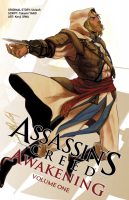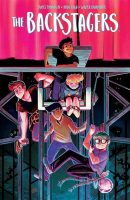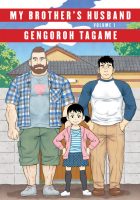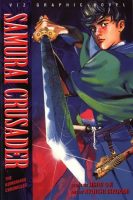My News and Reviews
I was away last week traveling for work as well as for yet another family wedding (this year has been full of them), but I still managed to post a review before it was all said and done. It’s several month’s later than I really intended it to be since the manga was actually released back in May, but I’ve finally reviewed the first omnibus of My Brother’s Husband by Gengoroh Tagame. The manga was easily one of my most anticipated releases for 2017. I’ve actually been collecting the series in Japanese (even though my reading comprehension of the language isn’t quite where it needs to be yet), but I am incredibly happy that it’s being translated into English. I’m not sure when the second and final omnibus is scheduled to be released, but there’s not question that I’ll be picking it up once it’s available.
Quick Takes
 Assassin’s Creed: Awakening, Volume 1 written by Takashi Yano and illustrated by Kenji Oiwa. There have been numerous Assassin’s Creed comic adaptations published by Titan Comics, so including Yano and Oiwa’s Awakening as part of its catalog seems an obvious choice to make even though the publisher doesn’t typically release many manga. Admittedly, I’ve not played very much of any of the Assassin’s Creed video games (although what I have played I’ve largely liked) and I’m not especially familiar with Assassin’s Creed IV: Black Flag, the installment upon which Awakening is loosely based. What primarily drew me to the series was the involvement of Oiwa, one of the creators behind the manga adaptations of Otsuichi’s Goth and Welcome to the N.H.K., both of which I greatly enjoyed. Awakening alternates between two stories taking place in different time periods which turn out to be deeply connected to each other although the depth of that connection isn’t immediately clear. The first, and the one I prefer, is set in the early eighteenth century and follows Edward Kenway, a pirate captain who gets caught up in the conflict between the Templars and Assassins. Centuries later, that conflict is still ongoing, impacting the life of Masato Yagyu and his family in unexpected ways.
Assassin’s Creed: Awakening, Volume 1 written by Takashi Yano and illustrated by Kenji Oiwa. There have been numerous Assassin’s Creed comic adaptations published by Titan Comics, so including Yano and Oiwa’s Awakening as part of its catalog seems an obvious choice to make even though the publisher doesn’t typically release many manga. Admittedly, I’ve not played very much of any of the Assassin’s Creed video games (although what I have played I’ve largely liked) and I’m not especially familiar with Assassin’s Creed IV: Black Flag, the installment upon which Awakening is loosely based. What primarily drew me to the series was the involvement of Oiwa, one of the creators behind the manga adaptations of Otsuichi’s Goth and Welcome to the N.H.K., both of which I greatly enjoyed. Awakening alternates between two stories taking place in different time periods which turn out to be deeply connected to each other although the depth of that connection isn’t immediately clear. The first, and the one I prefer, is set in the early eighteenth century and follows Edward Kenway, a pirate captain who gets caught up in the conflict between the Templars and Assassins. Centuries later, that conflict is still ongoing, impacting the life of Masato Yagyu and his family in unexpected ways.
 The Backstagers, Volume 1: Rebels without Applause written by James Tynion IV, illustrated by Rian Sygh, and colors by Walter Baiamonte. I believe The Backstagers first came to my attention when it was featured on a list of ongoing comics series which included trans characters. And indeed, one of the characters in The Backstagers–and an important main character at that–is a transguy, something that is almost unheard of in mainstream comics. (Also of note, the series’ co-creator and illustrator is also trans, which I hadn’t initially realized.) That was enough to make me interested in the series, and the first volume was more than enough to make me a fan. The Backstagers is set at an all-boys high school and largely follows the stage crew of the drama club. Jory, a recent transfer student, who at first he thought he wanted to be an actor ultimately finds himself swept up in the magic of what happens behind the scenes. Quite literally, actually. The Backstagers is a tremendous amount of high-energy fun with brightly colored artwork and sparkles, blushing, and flowers galore. The comic is also delightfully queer and diverse, breaking down gender stereotypes by presenting a wide variety of masculinities. I absolutely loved the first volume of The Backstagers and definitely look forward to more.
The Backstagers, Volume 1: Rebels without Applause written by James Tynion IV, illustrated by Rian Sygh, and colors by Walter Baiamonte. I believe The Backstagers first came to my attention when it was featured on a list of ongoing comics series which included trans characters. And indeed, one of the characters in The Backstagers–and an important main character at that–is a transguy, something that is almost unheard of in mainstream comics. (Also of note, the series’ co-creator and illustrator is also trans, which I hadn’t initially realized.) That was enough to make me interested in the series, and the first volume was more than enough to make me a fan. The Backstagers is set at an all-boys high school and largely follows the stage crew of the drama club. Jory, a recent transfer student, who at first he thought he wanted to be an actor ultimately finds himself swept up in the magic of what happens behind the scenes. Quite literally, actually. The Backstagers is a tremendous amount of high-energy fun with brightly colored artwork and sparkles, blushing, and flowers galore. The comic is also delightfully queer and diverse, breaking down gender stereotypes by presenting a wide variety of masculinities. I absolutely loved the first volume of The Backstagers and definitely look forward to more.
 Nirvana, Volume 1 by Jin and Sayuki. Due to her selflessness and devotion to volunteer efforts, Yachiyo Hitotose has become known as the Modern-Day Florence Nightingale. While on a trip to help those in need overseas, Yachiyo’s flight crashes and she suddenly finds herself reincarnated in another world known as Gulgraf. Believed to be the new embodiment of the divine goddess Sakuya, the bringer of light, Yachiyo has naturally taken upon herself to rescue and protect the residents of Gulgaf from the powers of darkness. As well-meaning as she is, Yachiyo will still need plenty of help if she wants to make a difference, especially as there are those who already want her dead. And so she sets off on an adventure, traveling across the world in search of allies as she learns to control the new powers she has been granted. Nirvana does seem to at least in part be be inspired by Buddhist and Hindu mythologies and mysticism–which honestly is what compelled me to give the series a try–but at this point they seem to be used mostly as a veneer and to provide the series’ most basic narrative structure and worldbuilding. I wasn’t as captivated as I was hoping to be with Nirvana, but I was still entertained by the first volume which takes a much more comedic approach than I was expecting.
Nirvana, Volume 1 by Jin and Sayuki. Due to her selflessness and devotion to volunteer efforts, Yachiyo Hitotose has become known as the Modern-Day Florence Nightingale. While on a trip to help those in need overseas, Yachiyo’s flight crashes and she suddenly finds herself reincarnated in another world known as Gulgraf. Believed to be the new embodiment of the divine goddess Sakuya, the bringer of light, Yachiyo has naturally taken upon herself to rescue and protect the residents of Gulgaf from the powers of darkness. As well-meaning as she is, Yachiyo will still need plenty of help if she wants to make a difference, especially as there are those who already want her dead. And so she sets off on an adventure, traveling across the world in search of allies as she learns to control the new powers she has been granted. Nirvana does seem to at least in part be be inspired by Buddhist and Hindu mythologies and mysticism–which honestly is what compelled me to give the series a try–but at this point they seem to be used mostly as a veneer and to provide the series’ most basic narrative structure and worldbuilding. I wasn’t as captivated as I was hoping to be with Nirvana, but I was still entertained by the first volume which takes a much more comedic approach than I was expecting.





